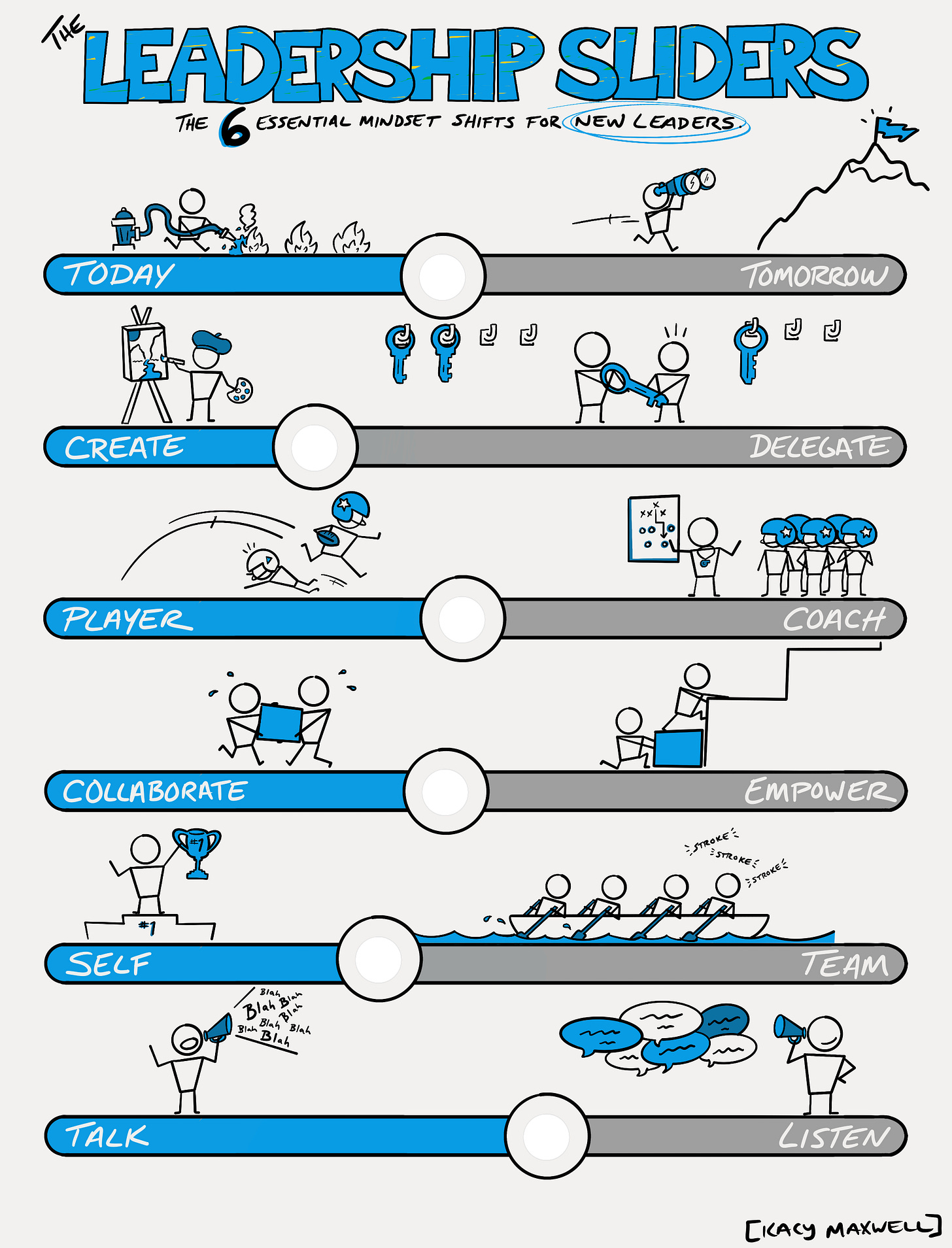Entry 02: The 6 Key Leadership Shifts
It's not a light switch. It's a sliding scale.
🎧 Listen to me read this post! 👇
Stepping into leadership for the first time can feel like entering an entirely new world. As an individual contributor, your success was measured by your ability to execute, how well you completed tasks, solved problems, and delivered results. You were responsible for your own work, and the formula for success was relatively straightforward: work hard, develop expertise, and prove your value through your contributions.
But as you move into a leadership role, everything changes. Your success is no longer just about what you accomplish, it’s about how well you enable others to succeed. The skills that made you a high performer as an individual contributor won’t necessarily make you a great leader. Instead, you have to shift the way you think and how you interact with your team.
It’s a Sliding Scale, Not a Light Switch 🎚️
One of the most important things I have realized about leadership is that it’s not about flipping a switch, it’s about learning to adjust on a sliding scale. It feels like is should be a light switch because that’s how you became a leader. One day you weren’t one and then next day you were. But the skills needed to lead well don’t happen that quickly. Leadership requires balance, and different situations demand different approaches.
Imagine a scale where one end represents the mindset of an individual contributor, and the other represents the mindset of a leader. Throughout your leadership journey, you’ll need to move along this scale depending on the context, your team’s needs, and your organization’s goals.
Through my experience, I’ve identified six fundamental mindset shifts that a leader must make. Some seasons, you’ll feel yourself leaning toward one side, and on others, you’ll need to adjust to the opposite end. The key is recognizing when and how to shift so that you can lead effectively. The next 6 entries on Drawn to Lead will unpack each shift in more depth, but below is a high-level overview and an exercise for you to do today.
SHIFT 1: From Today to the Future 📆
As an individual contributor, your focus was on getting things done today, solving immediate problems, meeting deadlines, and handling urgent tasks. But as a leader, you have to start thinking beyond the present and set a clear vision for the future. You’re no longer just responsible for executing, you’re responsible for guiding your team toward long-term success.
SHIFT 2: From Creating to Delegating 🔓
You used to be hands-on, directly involved in every task and project. But leadership requires you to step back and trust your team to take ownership. If you try to do everything yourself, you’ll burn out and prevent your team from growing. Delegation isn’t about offloading work, it’s about empowering others to step up.
SHIFT 3: From Player to Coach 📋
As an individual contributor, success was about your own performance. But in leadership, your job is no longer to be the best player, it’s to develop and elevate others. Just like a coach doesn’t take the shots but prepares the team to win, a leader’s role is to mentor, guide, and build others into high performers.
SHIFT 4: From Self to Team 👨💻👩💻🧑💻
Early in your career, you were rewarded for your personal achievements. But as a leader, your wins are measured by how well your team performs. Great leaders shift their focus from individual success to creating an environment where the entire team can thrive.
SHIFT 5: From Collaborating to Empowering 🚧
Collaboration is essential, but there’s a difference between being involved in everything and empowering your team to work independently. Leaders must build teams that can operate effectively without constant oversight. This shift allows your team to grow and take ownership, while you focus on strategy and vision.
SHIFT 6: From Talking to Listening 👂🎧
As an individual contributor, you likely focused on making your voice heard, sharing ideas, contributing solutions, and speaking up. But leadership requires a shift toward active listening. Great leaders ask more questions, create space for discussion, and truly hear what their team has to say before making decisions.
Reflective Exercise: Where are you today?
To determine which of these you need to start sliding to the right first, you need to figure out where you are today. Get a piece of paper and draw the sliders or download the worksheet below. Then, think/journal through the following questions:
Where do I fall on each of these sliders?
Where do I need to shift more to the right for my current team?
Your first thought may be that you want to shift all of them, but choose one or two to focus on first.
Over the next series of posts, we’ll dive deeper into each of these six shifts, focusing on practical applications, challenges, and strategies to help you get started on these shifts effectively. I’m excited to walk with you on this journey. If you have any questions, feel free to message me directly.
- Kacy @ Drawn to Lead




These are great points. It really comes down to self-awareness and wanting to be a great leader!